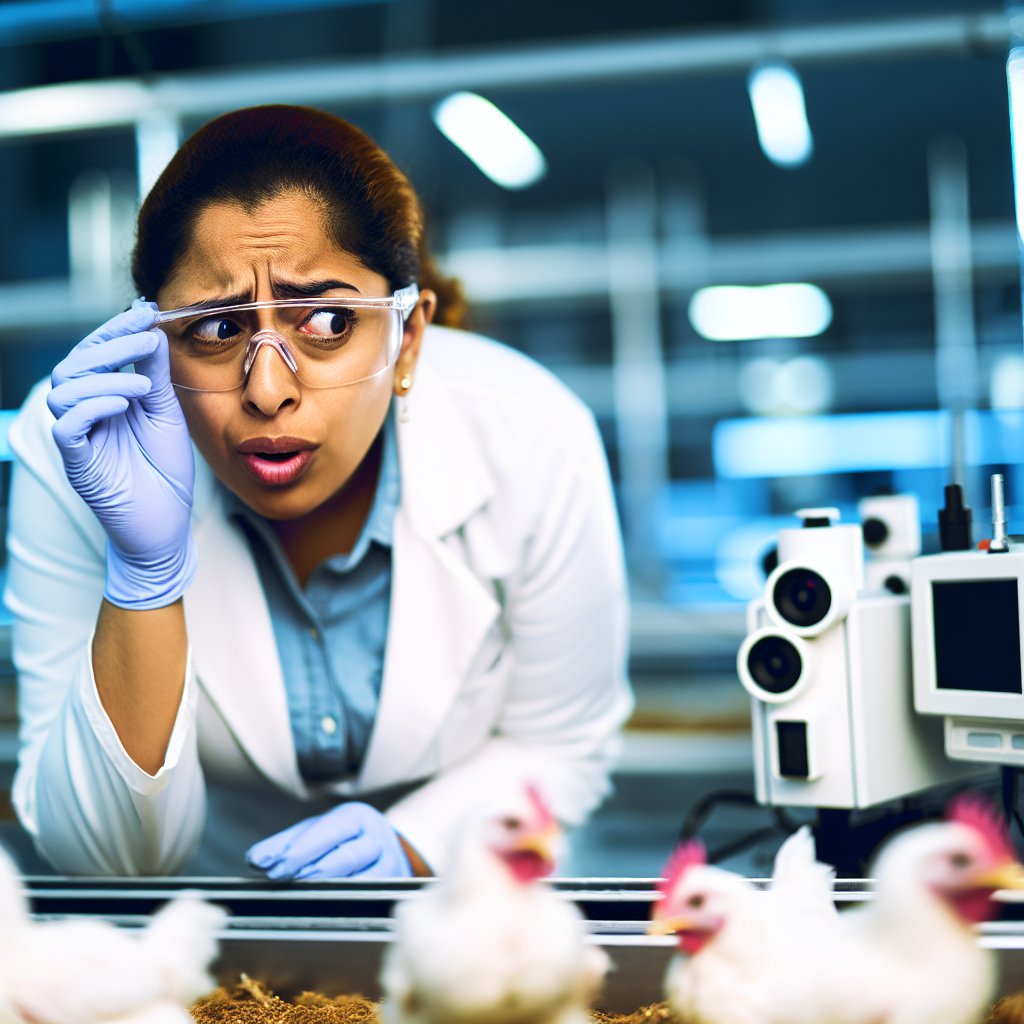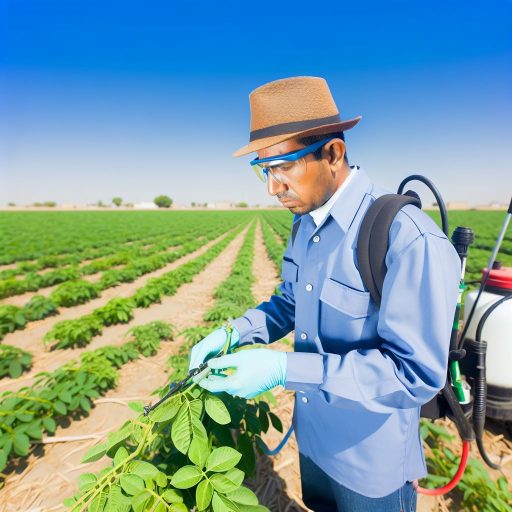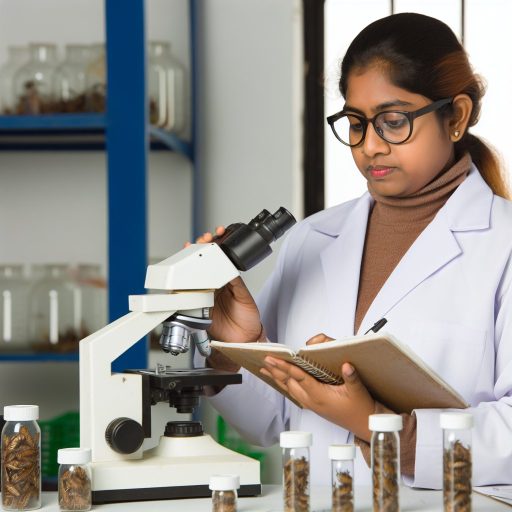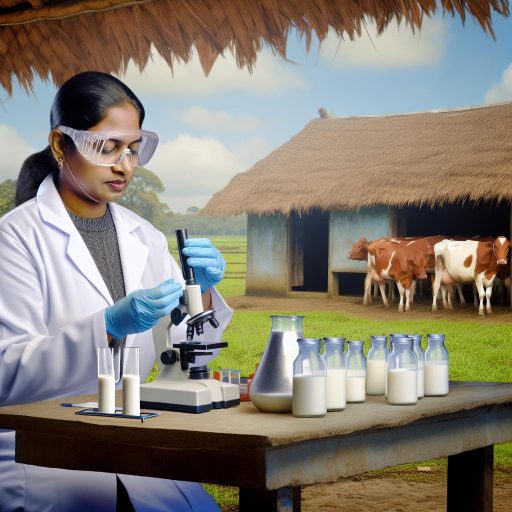Introduction:
Poultry science and technology play a crucial role in today’s world by providing a sustainable source of protein and employment opportunities.
With the advancements in biotechnology and automation, the future of poultry science and technology looks promising.
The integration of cutting-edge technologies such as artificial intelligence and genetics is set to revolutionize the poultry industry.
Key Developments:
One major area of focus in the future of poultry science and technology is genetic engineering.
Scientists are working on developing poultry breeds that are more resilient to diseases and environmental stressors.
This will lead to healthier and more productive birds, ultimately increasing the efficiency of the poultry industry.
Additionally, advances in precision nutrition will enable farmers to provide optimized diets for their birds, leading to improved growth rates and overall health.
Automation and Robotics:
Another significant advancement in the field is the adoption of automation and robotics.
Automated systems for feeding, watering, and monitoring bird health are becoming more prevalent, reducing labor costs and improving efficiency.
Robotics can also be utilized in egg collection and processing, ensuring quality control and consistency.
Sustainability and Environmental Impact:
The future of poultry science and technology is also marked by a strong emphasis on sustainability and reducing the industry’s environmental impact.
Innovations in waste management, energy efficiency, and water conservation are being developed to create a more eco-friendly poultry production system.
Innovation and Growth in Poultry Science:
In addition to genetic engineering and automation, the poultry industry is exploring new ways to improve animal welfare and food safety.
These advancements not only enhance production but also address consumer concerns.
By adopting these modern technologies, producers can ensure sustainability while meeting the growing demand for poultry products.
Current challenges in the poultry industry:
- Disease outbreaks are a major concern affecting poultry production globally.
- Food safety concerns related to poultry products have been on the rise.
- Environmental impact of poultry farming, including waste management, is a pressing issue.
Discussion on issues like disease outbreaks, food safety concerns, and environmental impact:
In recent years, the poultry industry has faced significant challenges that have highlighted the need for advancements in poultry science and technology.
One of the most critical issues is the frequent outbreaks of diseases among poultry flocks.
These diseases, such as avian influenza, Newcastle disease, and infectious bronchitis, can result in significant economic losses for poultry farmers.
Additionally, food safety concerns have become increasingly important in the poultry industry.
Consumers are becoming more aware of the potential risks associated with consuming poultry products that may contain harmful bacteria or pathogens.
Transform Your Career Today
Unlock a personalized career strategy that drives real results. Get tailored advice and a roadmap designed just for you.
Start NowThis has led to stricter regulations and guidelines for poultry producers to ensure the safety of their products.
Furthermore, the environmental impact of poultry farming cannot be ignored.
The industry is a significant contributor to greenhouse gas emissions, water pollution, and land degradation.
Managing poultry waste, including manure and feed residues, is a critical aspect of sustainable poultry production.
Overview of how these challenges drive the need for advancements in poultry science and technology:
Given the complexity and severity of these challenges, there is a growing demand for innovative solutions to address them.
Poultry science and technology play a crucial role in developing strategies to mitigate disease outbreaks, improve food safety, and reduce the environmental footprint of poultry farming.
Advancements in genetics and breeding techniques have enabled the development of disease-resistant poultry breeds that are more resilient to common poultry diseases.
This is essential for preventing disease outbreaks and minimizing the need for antibiotics in poultry production.
In terms of food safety, advancements in processing technologies, such as pasteurization and irradiation, have helped reduce the risk of contamination in poultry products.
These technologies ensure that poultry products are safe for consumers to consume while maintaining their nutritional quality.
Regarding environmental impact, innovations in waste management and recycling technologies have helped poultry farmers reduce their carbon footprint and minimize pollution.
Techniques such as anaerobic digestion and composting can convert poultry waste into renewable energy sources and organic fertilizers, thereby promoting sustainability in poultry production.
The challenges facing the poultry industry necessitate continuous advancements in poultry science and technology to ensure the sustainability and efficiency of poultry production.
By addressing issues such as disease outbreaks, food safety concerns, and environmental impact, the industry can thrive and meet the growing demand for safe and environmentally friendly poultry products.
Emerging technologies in poultry production
As the poultry industry continues to evolve, emerging technologies are playing a crucial role in revolutionizing the way poultry is raised and processed.
Here are some of the key innovations that are transforming poultry production:
Precision farming
Precision farming involves the use of advanced technologies such as GPS, sensors, and drones to optimize various aspects of poultry production.
By precisely monitoring and controlling factors such as feed distribution, water consumption, and environmental conditions, farmers can ensure optimal conditions for their birds.
Automation
Automation is another key technology that is rapidly gaining traction in poultry production.
From automated feeding systems to robotic egg collectors, automation streamlines many aspects of poultry farming.
Transform Your Career Today
Unlock a personalized career strategy that drives real results. Get tailored advice and a roadmap designed just for you.
Start NowThis reduces labor costs and increases efficiency. This allows farmers to focus on higher-level tasks and decision-making.
Data analysis
Data analysis is becoming increasingly important in poultry production, as it allows farmers to make informed decisions based on real-time data.
By collecting and analyzing data on factors such as feed conversion rates, disease outbreaks, and production yields, farmers can optimize their operations for greater efficiency and profitability.
Overall, these emerging technologies are revolutionizing the poultry industry by improving efficiency, productivity, and sustainability.
As the industry continues to embrace innovation, we can expect to see even more advancements in the future that will further transform poultry production.
Learn More: Sustainable Practices for Farm Managers
Benefits of incorporating artificial intelligence and machine learning in poultry science:
- Discussion on how AI and ML can improve decision-making processes, optimize production efficiency, and enhance animal welfare.
- Examples of successful applications of AI and ML in the poultry industry.
Improving decision-making processes:
Artificial intelligence and machine learning algorithms can analyze vast amounts of data and provide valuable insights for poultry farmers.
This data-driven approach allows for better decision-making that is based on real-time information and predictive analytics.
By using AI and ML, farmers can optimize their production processes, identify potential risks, and make informed choices to maximize efficiency and profitability.
Optimizing production efficiency:
AI and ML technologies can revolutionize the way poultry farms operate by streamlining various tasks and processes.
For example, predictive analytics can forecast market trends, predict feed consumption, and optimize breeding programs to meet consumer demand.
By automating routine tasks, monitoring environmental conditions, and analyzing production data, AI and ML can help farmers improve feed conversion rates, reduce waste, and enhance overall efficiency.
Enhancing animal welfare:
One of the most significant benefits of incorporating AI and ML in poultry science is the potential to improve animal welfare.
By using sensors, cameras, and data analytics, farmers can monitor the health and behavior of their birds in real-time.
These technologies can detect early signs of disease, track feeding patterns, and ensure optimal living conditions for the birds.
By promoting better animal welfare practices, AI and ML contribute to the overall sustainability and ethical standards of the poultry industry.
Successful applications of AI and ML in the poultry industry:
- Smart monitoring systems: AI-powered sensors and cameras can monitor the health and behavior of birds, detect anomalies, and alert farmers in real-time.
- Predictive analytics: Machine learning algorithms can forecast market trends, predict disease outbreaks, and optimize production processes to maximize efficiency.
- Automated feeding systems: AI-driven feeders can adjust feeding schedules, portion sizes, and nutritional requirements based on individual bird needs.
- Breeding programs optimization: ML algorithms can analyze genetic data, predict breeding outcomes, and enhance the genetic potential of poultry populations.
- Disease detection: AI systems can analyze health data, detect early signs of disease, and facilitate timely interventions to prevent outbreaks and minimize losses.
See Related Content: Understanding Collateral in Agricultural Loans
Sustainable practices in poultry farming:
– Overview of the importance of sustainability in modern agriculture
– Explanation of how technologies like biodegradable packaging, water recycling systems, and renewable energy sources are shaping the future of poultry farming
Importance of Sustainability in Modern Agriculture
In the current global scenario, sustainability has become a crucial aspect of modern agriculture.
Transform Your Career Today
Unlock a personalized career strategy that drives real results. Get tailored advice and a roadmap designed just for you.
Start NowWith the increasing population and the growing demand for food, it is essential to adopt sustainable practices to ensure the long-term viability of poultry farming.
By focusing on sustainability, farmers can reduce their environmental impact, conserve resources, and improve the overall efficiency of their operations.
Technologies Shaping the Future of Poultry Farming
Biodegradable packaging:
One key technology that is shaping the future of poultry farming is the use of biodegradable packaging materials.
These materials are designed to break down naturally over time, reducing the amount of waste generated by poultry farms.
By eliminating plastic packaging, farmers can reduce their environmental footprint and contribute to a more sustainable food system.
Water recycling systems:
Water is a precious resource, and poultry farming requires large amounts of water for various processes.
To address this issue, many farms are implementing water recycling systems that allow them to treat and reuse water on-site.
This not only reduces water consumption but also minimizes pollution from runoff and wastewater discharges.
By using water more efficiently, farmers can lower their operating costs and decrease their environmental impact.
Renewable energy sources:
Another important technology shaping the future of poultry farming is the use of renewable energy sources such as solar power and wind energy.
By harnessing these sustainable energy sources, farmers can reduce their reliance on fossil fuels and lower their greenhouse gas emissions.
This not only helps to combat climate change but also offers long-term cost savings for poultry producers.
Additionally, renewable energy sources provide farmers with energy independence and resilience in the face of fluctuating energy prices.
Overall, sustainable practices in poultry farming are essential for ensuring the long-term viability of this industry.
By adopting technologies like biodegradable packaging, water recycling systems, and renewable energy sources, farmers can reduce their environmental impact, conserve resources, and improve the efficiency of their operations.
These innovations are shaping the future of poultry farming towards a more sustainable and environmentally friendly path.
You Might Also Like: Top Skills for Artificial Insemination Technicians
Transform Your Career Today
Unlock a personalized career strategy that drives real results. Get tailored advice and a roadmap designed just for you.
Start NowGenetic Advancements in Poultry Breeding
Genetic engineering plays a crucial role in developing disease-resistant and high-yielding poultry breeds.
By manipulating the genetic makeup of chickens, scientists can enhance certain traits that are beneficial for the poultry industry.
Selective breeding has been used for centuries to improve specific characteristics in poultry.
However, with genetic engineering, researchers can directly alter genes to achieve desired outcomes.
This can lead to faster growth rates, increased egg production, and better immunity to diseases.
Benefits of Genetic Modifications in Poultry
The use of genetic modifications in poultry breeding has several advantages.
Disease-resistant breeds are more likely to survive outbreaks, reducing the need for antibiotics and medications.
High-yielding poultry breeds can increase productivity and meet the growing demand for poultry products.
Genetic advancements also allow for a more sustainable poultry industry.
By creating breeds that require fewer resources, such as feed and water, genetic engineering can help reduce environmental impact and improve efficiency in poultry production.
Ethical Considerations in Genetic Breeding
While genetic engineering offers many benefits, it also raises ethical concerns.
Some people argue that altering the genetic makeup of animals is unnatural and goes against the principles of animal welfare.
There are concerns about the well-being of genetically modified poultry and the potential long-term effects on human health.
Another ethical consideration is the impact of genetic modifications on biodiversity.
Introducing genetically modified poultry breeds into the environment can affect the genetic diversity of wild bird populations, potentially leading to unforeseen consequences in the ecosystem.
Potential Controversies Surrounding Genetic Modifications
The use of genetic modifications in poultry breeding is not without controversy.
Some people are concerned about the safety of consuming genetically modified poultry products.
There are questions about the potential allergenicity of genetically modified proteins and the unknown risks associated with consuming these products.
Additionally, there is a debate about the transparency of genetic modifications in the poultry industry.
Consumers may be wary of purchasing genetically modified poultry products without clear labeling and information about the genetic modifications involved.
Transform Your Career Today
Unlock a personalized career strategy that drives real results. Get tailored advice and a roadmap designed just for you.
Start NowDiscover More: Crop Rotation and Planning for Farm Managers

Effects of Climate Change on Poultry Production
Climate change can have a significant impact on poultry production in various ways.
One of the most immediate effects is the alteration of natural habitats and ecosystems where poultry is raised.
This can lead to a decrease in the availability of suitable land for poultry farming, as well as changes in the availability of feed and water sources.
Additionally, changing weather patterns can increase the prevalence of diseases and parasites that affect poultry health.
Warmer temperatures and increased humidity provide ideal conditions for the growth and spread of pathogens, leading to higher mortality rates among poultry flocks.
Strategies to Mitigate the Effects of Climate Change
Fortunately, there are several strategies and technologies that can help poultry producers mitigate the effects of climate change on their operations.
One such strategy is the implementation of sustainable farming practices that reduce the carbon footprint of poultry farms.
For example, using renewable energy sources such as solar or wind power to generate electricity can help reduce greenhouse gas emissions associated with poultry production.
Additionally, practices such as water conservation and waste management can help minimize the environmental impact of poultry farming.
Another important strategy is the development and adoption of new breeding techniques that produce poultry breeds that are more resilient to changing environmental conditions.
This can help reduce the susceptibility of poultry flocks to diseases and parasites, as well as improve their overall productivity and efficiency.
Technological Innovations in Poultry Production
Advancements in technology have also played a significant role in shaping the future of poultry production in the face of climate change.
One such innovation is the use of precision agriculture techniques to optimize resource utilization and minimize environmental impact.
For example, the use of sensors and monitoring devices can help poultry producers collect data on environmental conditions, feed intake, and animal health in real-time.
This information can then be used to make informed decisions about how to best manage poultry flocks and minimize the effects of climate change.
Additionally, the development of new feed formulations and supplements that are tailored to the specific needs of poultry can help improve their health and performance in the face of changing environmental conditions.
These innovative products can help poultry producers maintain high levels of productivity and profitability despite the challenges posed by climate change.
Implications for Future Poultry Production
The potential impact of climate change on poultry production is a crucial issue that must be addressed to ensure the sustainability and viability of the poultry industry.
By exploring the effects of climate change on poultry farming and implementing strategies and technologies to mitigate these effects, poultry producers can adapt to a changing environment.
Transform Your Career Today
Unlock a personalized career strategy that drives real results. Get tailored advice and a roadmap designed just for you.
Start NowThey can continue to thrive in the future.
Consumer Trends in the Poultry Industry
In recent years, there has been a significant shift in consumer preferences when it comes to poultry products.
Not only are consumers becoming more conscious of what they eat, but they are also concerned about how the food they consume is produced.
One of the key consumer trends in the poultry industry is the growing demand for organic poultry products.
Consumers are increasingly seeking poultry products that have been produced without the use of synthetic fertilizers, pesticides, or genetically modified organisms.
This trend is driven by a desire for healthier and more environmentally friendly food options.
Another important trend is the demand for antibiotic-free poultry products.
Consumers are becoming more aware of the potential health risks associated with the overuse of antibiotics in poultry production.
As a result, there is a growing preference for poultry products that have been raised without the routine use of antibiotics.
Furthermore, consumers are showing a strong interest in humanely raised poultry products.
This trend reflects a growing concern for animal welfare and the ethical treatment of animals in the food production process.
Consumers are looking for poultry products that come from farms where animals are raised in stress-free environments and have access to outdoor spaces.
Adapting Poultry Science and Technology
To meet these changing consumer preferences, the poultry industry is leveraging advancements in science and technology.
Poultry scientists and researchers are constantly innovating to develop new production methods that align with consumer demands for organic, antibiotic-free, and humanely raised poultry products.
One way that poultry science is adapting is through the development of organic poultry farming practices.
Scientists are exploring alternative methods for pest and disease control, as well as experimenting with natural feed additives to promote the health and well-being of organic poultry flocks.
These efforts are aimed at ensuring that organic poultry products meet the strict standards set by organic certifying organizations.
In terms of antibiotic-free poultry production, researchers are focusing on finding alternative strategies to prevent and treat diseases in poultry without relying on antibiotics.
This includes the development of vaccines, probiotics, and other natural supplements that can boost the immune system of poultry and reduce the need for antibiotics.
Additionally, researchers are working on improving biosecurity measures to prevent the spread of diseases within poultry flocks.
Transform Your Career Today
Unlock a personalized career strategy that drives real results. Get tailored advice and a roadmap designed just for you.
Start NowWhen it comes to humanely raised poultry products, scientists are exploring ways to improve animal welfare standards in poultry production.
This includes researching new housing systems and management practices that provide poultry with ample space to move around and engage in natural behaviors.
By implementing these changes, poultry producers can ensure that their products meet the expectations of consumers who prioritize animal welfare.
Shaping the Future of the Poultry Industry
Consumer trends and preferences play a significant role in shaping the future of the poultry industry.
As consumers continue to demand organic, antibiotic-free, and humanely raised poultry products, the industry must adapt.
This adaptation involves incorporating innovative practices and technologies.
By staying attuned to consumer preferences and leveraging advancements in science and technology, the poultry industry can meet the evolving needs of consumers while ensuring the sustainability and welfare of poultry production.
The Future of Poultry Science and Technology
The future of poultry science and technology is promising.
Advancements in technology, genetics, and nutrition have paved the way for sustainable and efficient poultry production.
Continuous innovation and research play a crucial role in ensuring the industry’s growth and sustainability.
It is essential to keep pushing the boundaries of what is possible to meet the increasing demand for poultry products worldwide.
By emphasizing the importance of research and development, we can address challenges such as disease outbreaks, food safety concerns, and environmental impact, leading to a more resilient and productive poultry industry.
Ultimately, investing in cutting-edge technologies, sustainable practices, and skilled professionals will be key to shaping a brighter future for poultry science and technology.
Let us continue to foster collaboration, drive innovation, and strive for excellence in the poultry industry to meet the needs of a growing population sustainably.
Additional Resources
Poultry Science Department / Auburn University College of Agriculture




